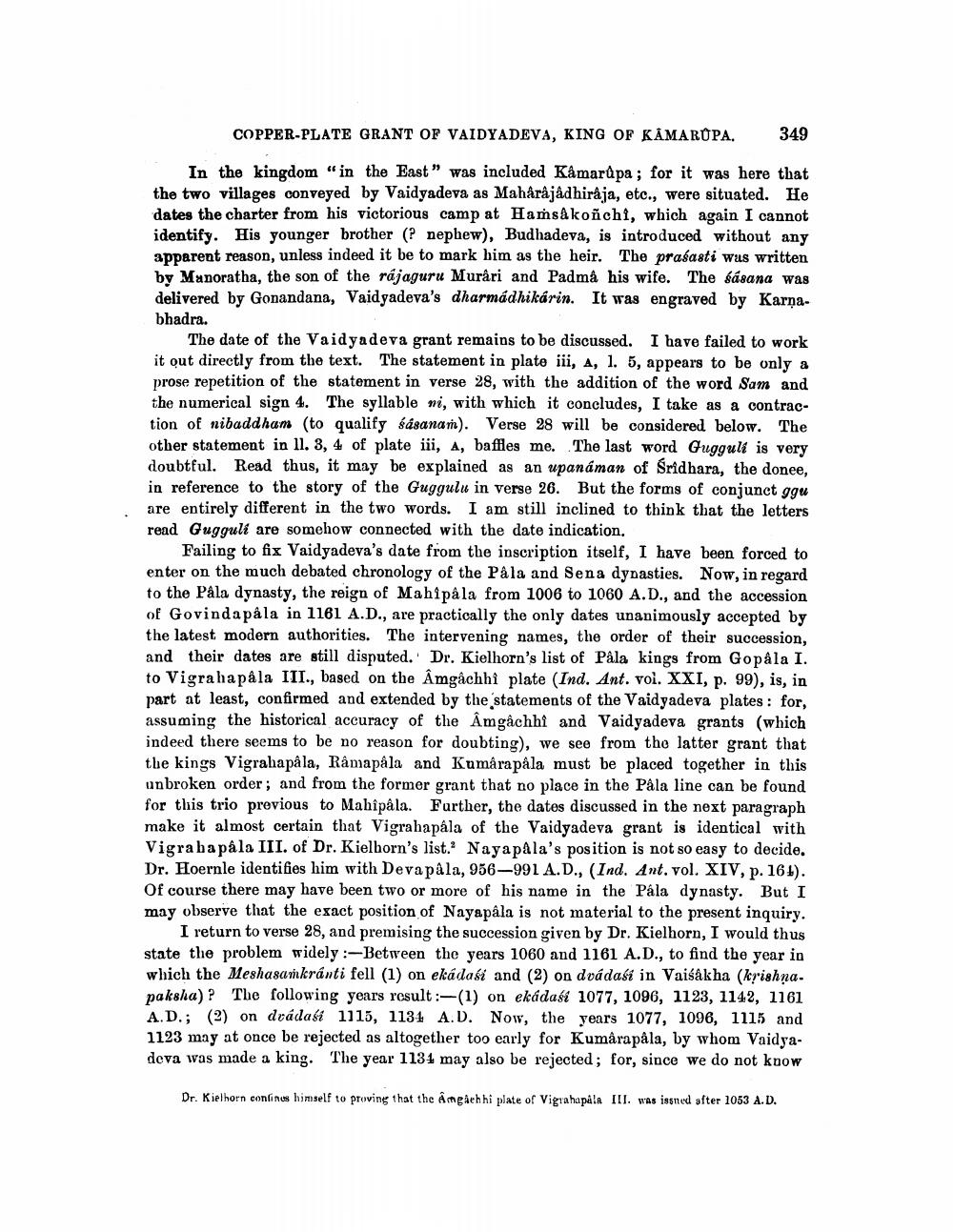________________
COPPER-PLATE GRANT OF VAIDYADEVA, KING OF KAMARUPA.
349
In the kingdom "in the East " was included Kamarupa; for it was here that the two villages conveyed by Vaidyadeva as Mahårâjadhiraja, etc., were situated. He dates the charter from his victorious camp at Hams&koñchi, which again I cannot identify. His younger brother (? nephew), Budhadeva, is introduced without any apparent reason, unless indeed it be to mark bim as the heir. The prasasti wus written by Manoratha, the son of the rájaguru Murâri and Padmå his wife. The sásana was delivered by Gonandana, Vaidyadeva's dharmádhikarin. It was engraved by Karnabhadra.
The date of the Vaidyadeva grant remains to be discussed. I have failed to work it out directly from the text. The statement in plate iii, A, 1. 5, appears to be only a prose repetition of the statement in verse 28, with the addition of the word Sam and the numerical sign 4. The syllable mi, with which it concludes, I take as a contraction of nibaddham (to qualify śásanam). Verse 28 will be considered below. The other statement in 11. 3, 4 of plate iii, A, baffles me. The last word Gugguli is very doubtful. Read thus, it may be explained as an upanáman of Sridhara, the donee, in reference to the story of the Guggulu in verse 26. But the forms of conjunct gou are entirely different in the two words. I am still inclined to think that the letters read Gugguli are somehow connected with the date indication.
Failing to fix Vaidyadeva's date from the inscription itself, I have been forced to enter on the much debated chronology of the Pala and Sena dynasties. Now, in regard to the Pala dynasty, the reign of Mahipala from 1006 to 1060 A.D., and the accession of Govinda pala in 1161 A.D., are practically the only dates unanimously accepted by the latest modern authorities. The intervening names, the order of their succession, and their dates are still disputed. Dr. Kielhorn's list of Påla kings from Gopala I. to Vigrahapala III., based on the Amgâchhi plate (Ind. Ant. vol. XXI, p. 99), is, in part at least, confirmed and extended by the statements of the Vaidyadeva plates : for, assuming the historical accuracy of the Amgâchhi and Vaidyadeva grants (which indeed there seems to be no reason for doubting), we see from the latter grant that the kings Vigrahapala, Râmapala and Kumarapala must be placed together in this unbroken order; and from the former grant that no place in the Pâla line can be found for this trio previous to Mahîpåla. Farther, the dates discussed in the next paragraph make it almost certain that Vigrahapala of the Vaidyadeva grant is identical with Vigra ba pâla III. of Dr. Kielhorn's list.? Nayapala's position is not so easy to decide. Dr. Hoernle identifies him with Deva pala, 956–991 A.D., (Ind. Ant. vol. XIV, p. 166). Of course there may have been two or more of his name in the Pála dynasty. But I may observe that the exact position of Nayapala is not material to the present inquiry.
I return to verse 28, and premising the succession given by Dr. Kielhorn, I would thus state the problem widely :-Between the years 1060 and 1161 A.D., to find the year in which the Meshasankranti fell (1) on ekádasi and (2) on dvadasi in Vaisakha (krishna. paksha)? The following years result:-(1) on ekadasi 1077, 1096, 1123, 1142, 1161 A.D.; (2) on dvadasi 1115, 1134 A.D. Now, the years 1077, 1096, 1115 and 1123 may at once be rejected as altogether too early for Kumarapala, by whom Vaidyadeva was made a king. The year 1134 may also be rejected; for, since we do not know
Dr. Kielhorn continos himself to proving that the â mgåeh hi plate of Vigiahapala III. was issned after 1053 A.D.




